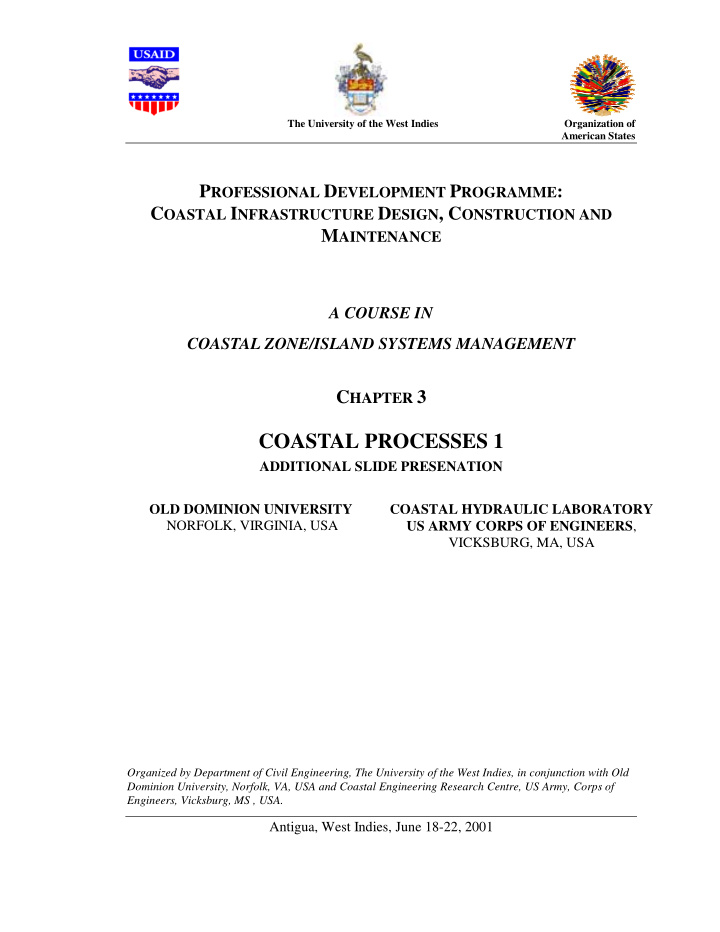



The University of the West Indies Organization of American States P ROFESSIONAL D EVELOPMENT P ROGRAMME : C OASTAL I NFRASTRUCTURE D ESIGN , C ONSTRUCTION AND M AINTENANCE A COURSE IN COASTAL ZONE/ISLAND SYSTEMS MANAGEMENT C HAPTER 3 COASTAL PROCESSES 1 ADDITIONAL SLIDE PRESENATION OLD DOMINION UNIVERSITY COASTAL HYDRAULIC LABORATORY NORFOLK, VIRGINIA, USA US ARMY CORPS OF ENGINEERS , VICKSBURG, MA, USA Organized by Department of Civil Engineering, The University of the West Indies, in conjunction with Old Dominion University, Norfolk, VA, USA and Coastal Engineering Research Centre, US Army, Corps of Engineers, Vicksburg, MS , USA. Antigua, West Indies, June 18-22, 2001
A RIVER OF SAND A RIVER OF SAND Video (20 minutes) by Professor Douglas Inman, Ph.D. Scripps Institute of Oceanography and, John S. Shelton, Ph.D. American Geological Institute available from Encyclopedia Britannica Educational Corp. Chicago, Illinois 1967
THE BEACH: A RIVER OF SAND (video) Summary THE BEACH: A RIVER OF SAND (video) Summary • Sand for beaches comes from upstream mountains • Beaches are formed by the seasonal variation of w aves • Waves breaking at angle cause sand transport along the beach, like a river of sand • Man’s structures (harbors, breakw aters, upland dams, etc.) interrupt the sand movement US Army Corps of Engineers
THE BEACH: A RIVER OF SAND (video) Summary THE BEACH: A RIVER OF SAND (video) Summary • Conclusion “Whenever man interferes with such a system, he becomes involved in its operation. To the degree that man upsets the natural balance of the system, he and his machines must do the work that nature did before.” Inman and Shepard, 1967 US Army Corps of Engineers
Waves (c) P ocket beach Rocky headland Rocky headland Narrow rocky shorelines E q u i l i b r W i u m H , M Y , st able Reference Baseline Dune, cliff, man's art ifact s and veget at ion
THE BEACH: A RESERVOIR OF SAND THE BEACH: A RESERVOIR OF SAND • Naturally, stable shorelines include rocky headland/bay beaches and pocket beaches. • The minimum dry beach w idth, Y min (or volume) depends on storm w ave energy. • Beaches are shaped by the seasonal variation of w aves. • Storm w aves drag sand offshore to build bars. US Army Corps of Engineers
THE BEACH: A RESERVOIR OF SAND THE BEACH: A RESERVOIR OF SAND • Normal w aves naturally rebuild beaches after storm events. • The beach is a reservoir of sand to mitigate coastal storm impacts. • Conclusion The beach is INFRASTRUCTURE for coastal storm hazard mitigation and must be maintained if erosion, man’s interference or extreme hurricane events diminish the reservoir volume. US Army Corps of Engineers
Recommend
More recommend